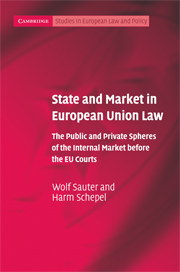 State and Market in European Union Law
State and Market in European Union Law Published online by Cambridge University Press: 22 January 2010
In this book we are concerned with one particular aspect of European economic law: the ways in which the European courts define and delineate the spheres of the ‘market’ and the ‘State’ in their various guises, and how they elaborate the relationship between these two categories. Hence, we deal with questions like the place of ‘the State’ in economic life, with the role of private actors and ‘the market’ in the provision of collective goods and, ultimately, with the relationship between economic freedoms and political rights. A large part of our enquiry will, inevitably, involve the question of whether (and if so, to what extent) EU internal market law reflects or propounds particular models of capitalism, such as neoliberalism or the ‘European social model’.
The constitutional question at issue is not limited to the specific balance between the forces of the free market and public intervention at this one (or any other) time in the history of European integration: the fundamental question is not so much where European law sets these boundaries, but how they are set. At the extremes, two contrasting answers to this question are possible. The first answer recognises that the extent to which political decision-making can assert itself over the market is itself properly a political decision. In the other model, the legitimate sphere of government intervention is defined by market failure and hence limited to those activities or services that cannot be provided by the market mechanism.
To save this book to your Kindle, first ensure [email protected] is added to your Approved Personal Document E-mail List under your Personal Document Settings on the Manage Your Content and Devices page of your Amazon account. Then enter the ‘name’ part of your Kindle email address below. Find out more about saving to your Kindle.
Note you can select to save to either the @free.kindle.com or @kindle.com variations. ‘@free.kindle.com’ emails are free but can only be saved to your device when it is connected to wi-fi. ‘@kindle.com’ emails can be delivered even when you are not connected to wi-fi, but note that service fees apply.
Find out more about the Kindle Personal Document Service.
To save content items to your account, please confirm that you agree to abide by our usage policies. If this is the first time you use this feature, you will be asked to authorise Cambridge Core to connect with your account. Find out more about saving content to Dropbox.
To save content items to your account, please confirm that you agree to abide by our usage policies. If this is the first time you use this feature, you will be asked to authorise Cambridge Core to connect with your account. Find out more about saving content to Google Drive.